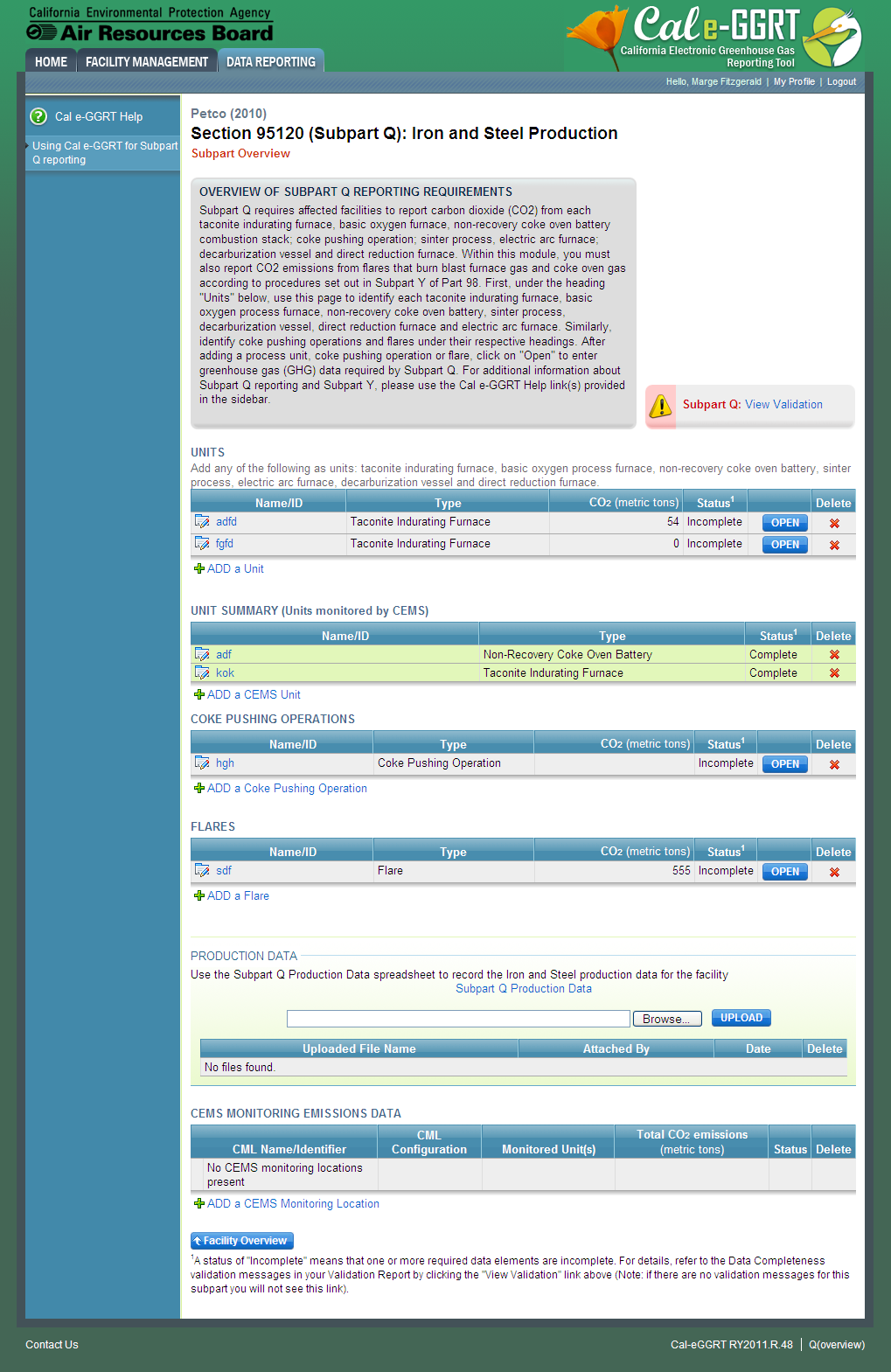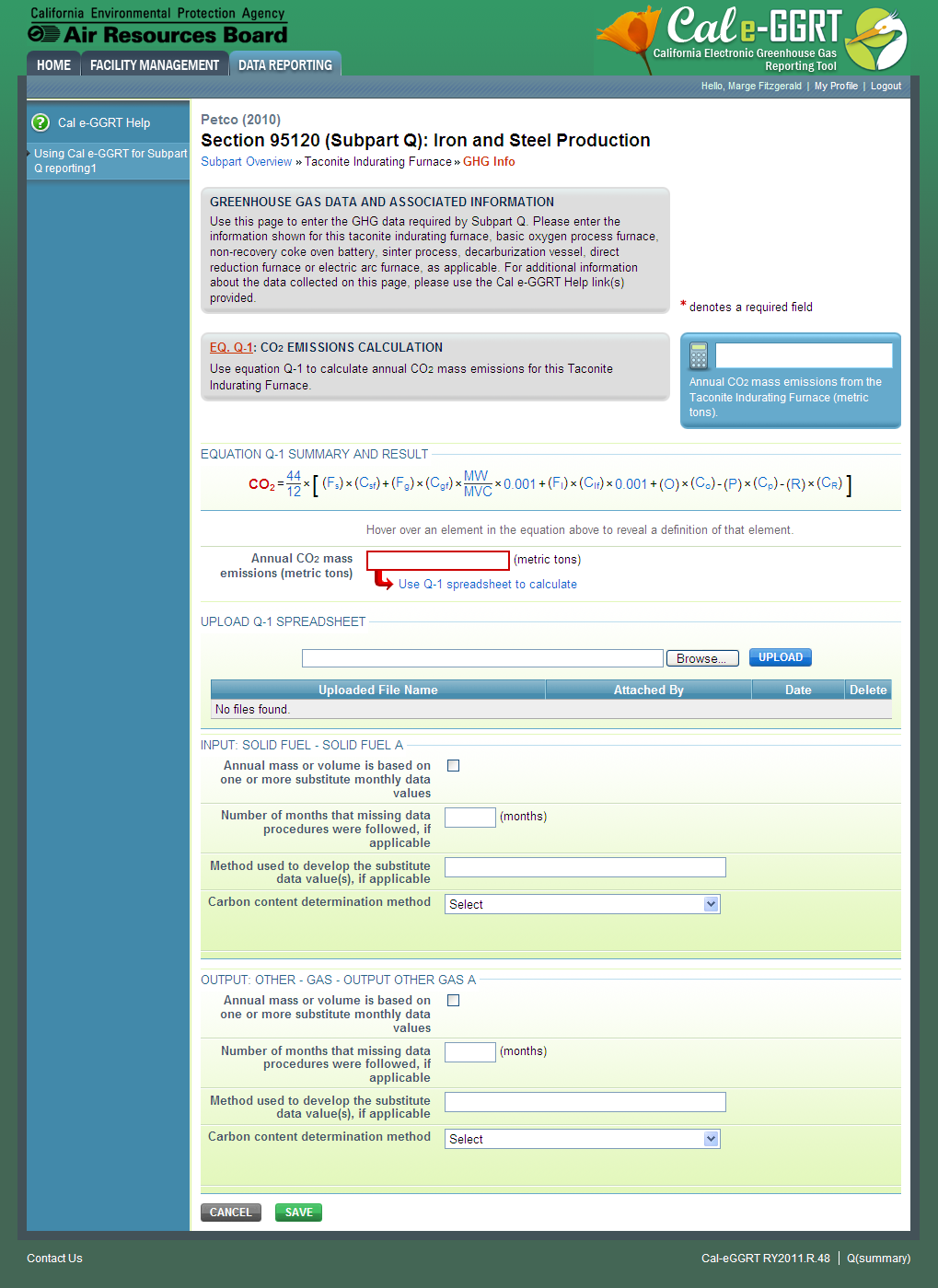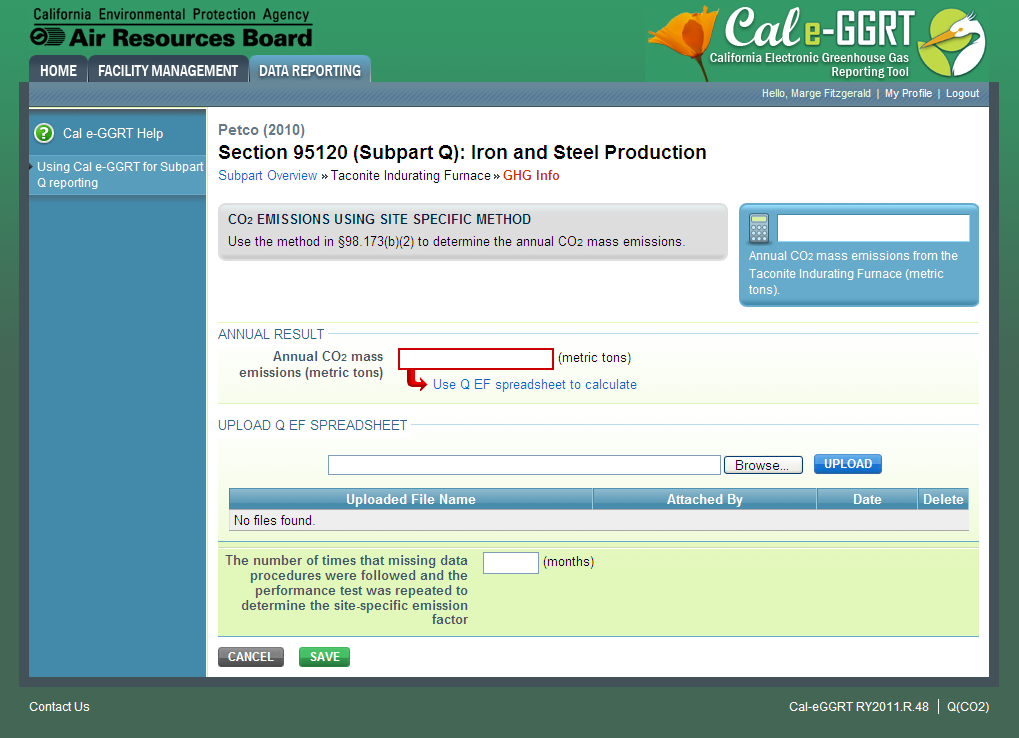This page provides step-by-step instructions on how to enter and edit Subpart Q Iron and Steel Production emissions information for process units that are NOT monitored by a Continuous Emissions Monitoring System (CEMS).
Step 1. Select a process unit
To enter emissions data for a process unit NOT monitored by CEMS for which to enter emissions data, find the unit in the UNITS table and click on the blue OPEN button in the second to last column. You will then be on the “GHG Info” form for each process type.
If the CO2 process emissions from the selected unit will be estimated using the carbon mass balance method, proceed to Section A - Carbon Mass Balance Method and execute steps A1-A4 for each type of process unit.
If the CO2 process emissions from the selected unit will be estimated using the site-specific emission factor method, proceed to Section B - Site-specific Emission Factor Method and execute steps B1-B2 for each process unit.
Click image to expand
Section A - Carbon Mass Balance Method
Step A1: Equation Summary and Result
For each process unit that is NOT monitored by CEMS at your facility and for which CO2 process emissions will be estimated using the carbon mass balance method, Subpart Q requires the following emissions information:
- The annual CO2 process emissions (the results from Equation Q-1, Q-2, Q-3, Q-4, Q-5, Q-6, or Q-7 in metric tons)
To calculate annual CO2 process emissions, follow these steps:
- Access the calculation spreadsheets for this subpart by clicking the link titled "Use Q-1 spreadsheet to calculate," located below the red emissions data entry box
- Follow the provided instructions. Similar spreadsheets are provided for applying mass balance equations (e.g. Q-2, Q-3, Q-4, Q-5, Q-6, or Q-7, etc ) for all relevant types of process units per the table below:
Process Unit Type |
Applicable Subpart Q Equation |
|---|---|
Taconite indurating furnace |
Equation Q-1 |
Basic oxygen process furnace |
Equation Q-2 |
Non-recovery coke oven battery |
Equation Q-3 |
Sinter process |
Equation Q-4 |
Electric arc furnace (EAF) |
Equation Q-5 |
Decarburization vessel |
Equation Q-6 |
Direct reduction furnace |
Equation Q-7 |
- Complete the calculation spreadsheet, and save
- Enter the annual CO2 process emissions result from the calculation spreadsheet into Cal e-GGRT
- Using the BROWSE and UPLOAD buttons in the UPLOAD Q-1 SPREADSHEET area provided, upload your calculation workbook to Cal-eGGRT
Click image to expand
Step A2: Input and output substitute data
For each input and output assigned to the process unit, enter the following substitute data information:
- Annual mass or volume is based on one or more substitute monthly data values. If this is not selected or is not applicable, you must enter zero, “0” in the box for the number of months with missing data. If you do not remember, you will receive a UNIT level validation message indicating that you have not completed entering data on this form in the validation report.
- Number of months that missing data procedures were followed, if applicable
- Method used to develop the substitute data value(s), if applicable. Enter information only if you applied missing data procedures, otherwise leave blank.
- Carbon content determination method, selected from the following, be sure the method selected is appropriate to the material being tested:
- Supplier
- ASTM C25-06
- ASTM D5373-08
- ASTM E1915-07a
- ASTM E1019-08
- ASM CS-104 UNS No. G10460
- ISO/TR 15349-3:1998
- Other (specify)
Step A3: Save Your Data
When you have finished entering annual emissions, inputs and outputs and identifying whether substitute data were used to determine mass or volume of input/outputs, click SAVE. You will then return to the Subpart Overview page and you should see the status of data entry for the unit change to “Complete” in the Status column in the UNITS table.
After you save the data on this page, the next time you open the page, the calculator on the top of the page will display the CO2 process emissions, rounded to the nearest metric ton. The value displayed is for informational purposes only.
Step A4: Repeat steps A1-A3
Repeat Steps A1-A3 until data have been entered for all process units NOT monitored by CEMS for which emissions were estimated using the carbon mass balance methods provide in the rule.
Section B - Site-specific Emission Factor Method
Step B1. Equation Q-8 (EF Approach) Summary and Result
For each process unit that is NOT monitored by CEMS at your facility and for which CO2 process emissions will be estimated using the site-specific emission factor method, Subpart Q requires the following emissions information:
- The annual CO2 process emissions (the results from Equation Q-8 and associated procedures in 98.73(b)(2)(i)-(iv) multiplied by the total amount of feed or production, as applicable, for the reporting period, in metric tons)
To calculate annual CO2 process emissions, follow these steps:
- Access the calculation spreadsheet for this subpart by clicking the link titled "Use Q EF spreadsheet to calculate," located below the red emissions data entry box
- Follow the provided instructions
- Complete the calculation spreadsheet, and Save
- Enter the annual CO2 process emissions result from the calculation spreadsheet into Cal e-GGRT
- Using the BROWSE and UPLOAD buttons in the UPLOAD Q EF SPREADSHEET area provided, upload your calculation workbook to Cal-eGGRT
When you have finished entering the required emissions data, click SAVE.
After you save the data on this page, the next time you open the page, the calculator on the top of the page will display the CO2 process emissions, rounded to the nearest metric ton. The value displayed is for informational purposes only.
Step B2: Repeat step B1
Repeat Steps B1 until data has been entered for all process units for which emissions were estimated using the site-specific emission factor method.
Click image to expand
See Also
Screen Errors
Using Cal e-GGRT to Prepare Your Subpart Q Report
Subpart Q Process Unit Information for Units NOT Monitored by CEMS
Subpart Q Process Unit Information for Units Monitored by CEMS
Subpart Q Coke Pushing Operations Information
Subpart Q Flares Information
Subpart Q Emissions Information for Units NOT Monitored by CEMS
Subpart Q Emissions Information for Units Monitored by CEMS
Subpart Q Emissions Information for Coke Pushing Operations
Subpart Q Emissions Information for Flares
Subpart Validation Report




